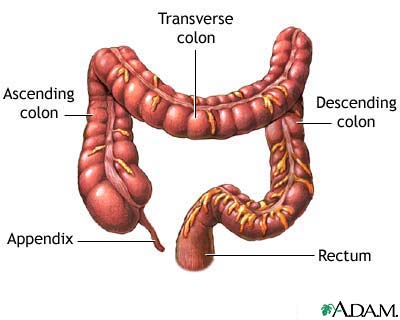Detoxification
The detoxification aspect of the first phase of
the mid-life tune up program involves the lower intestines, a much
neglected and hugely important part of our body, a place where
many diseases have their origin or where what is needed for rejuvenation
is frequently lacking.
People can read lots of opinions about the colon,
but in the 1970s, I learned that the average person has at
least 20-40 pounds of impacted material in the lower intestines.
I said this in a seminar once and a nurse raised her hand. She
introduced herself as someone who had often been present during
autopsies so I figured someone was about to contradict my statement.
Rather, she said she had seen as much as 90 pounds of impacted
fecal material in the corpses examined in the hospital where she
worked. I have seen people lose 35-40 pounds after a series of
colonics.
This is alarming because it implies a host of
problems that have relatively simple solutions. First, there is
the issue of peristalsis. Basically, starchy, sticky flour and
sugar makes good plaster of Paris. It adheres to the inside walls
of the intestines so that the tiny villi that should be exposed
and mobile in order to aid movement through the intestines are
plastered over with hardened food. This leads to constipation which,
in turn, leads to the accumulation of toxic gases that are absorbed
into the body and circulated as bubbles that cause spasms, twitching,
nervous irritation, and sometimes even more embarrassing problems
such as bad breath, flatulence, and involuntary noises.
I think we could make a fairly strong argument
for how constipation might also contribute to foul language and
rude allusions to the eliminatory system. The problem hardly stops
here.
Intestinal Flora
The next problem is that with constipation, there
is a serious probability of imbalance of intestinal flora. The
gut should have friendly bacteria. This is necessary for the healthy
breakdown of food. There is also some putrefactive bacteria in
the colon, but for many people, the ratios are the opposite of
what is healthy. Where people should have 85% friendly flora and
only 15% putrefactive bacteria, most people have 85% putrefactive
bacteria. The surest way to know whether or not this is the case
is by the odor in the bathroom. If other people are afraid to enter
after you leave, you might need probiotics!
When there is too much putrefactive bacteria,
there is a tendency for diseases to breed in the colon. This may
in turn spread to other parts of the body causing systemic illness.
Even this is just the tip of the iceberg!
Assimilation and Regeneration
The colon is not merely an eliminatory organ.
It is an organ of assimilation. According to Ayurveda, micronutrients
that are needed to regenerate the skin, hair, teeth, bones, reproductive
fluids, nerve sheaths, and brain are assimilated through the walls
of the colon. If those walls are coated with old food, the body
goes into a state of degeneration and premature aging. In short,
conditions associated with aging such as creaky joints, unsteady
gait, demineralization and fragility of the bones, and even memory
loss are all aggravated by an unhealthy colon.
Knowing all this, what can you do to make your
colon healthy?
Avoid
First, you want a healthy population of intestinal
flora. Once established, you want to maintain the flora so you
need to avoid the following:
The absolute worst case of colon abuse I ever
encountered involved a young woman who had had more than 40 operations
for broken bones, none of which were ever associated by either
her doctors or herself with her bowel habits. She aspired to be
beautiful which in her mind meant thin, very, very thin, but there
was a terrible cost associated with this thinness.
I suspect that between eating habits, horrible
choices of foods, awful drinking water, and antibiotics that at
least 90% of Americans have serious bowel problems that are usually
not considered to be a medical condition, certainly not one that
could have such serious ramifications for well-being.
Goals
The first goal of detoxification
is stabilization of bowel function. People must take food seriously
enough to know what contributes to constipation and what causes
diarrhea. Many might have a temporary need for probiotics to raise the level of friendly bacteria before restoring regularity.
In teaching situations, many people have told me privately that
they have been dependent upon laxatives since childhood. Some have
told me they are unable to have to a bowel movement even with laxatives.
They have to have enemas. I suggested to one such person, an elderly
lady who had been crippled by such problems since her teens, that
she buy a monthly meal ticket at a local Indian restaurant. She
said her life-long constipation was cured in a few hours.
Very few people understand that the
spices in foods stimulate both digestion and peristalsis. The aromatic
components are also detoxifying and carminative, meaning that the
nice smells neutralize the nasty odors.
Another wonderful anecdotal story
involved a practitioner who wished to become pregnant but was unwilling
to devote a lot of attention to diet and herbs. She said, "If
you had to limit your recommendations to one thing, what would
it be?" I felt she was tying my hands more than is comfortable
for me, but I told her "cayenne," not because cayenne
promotes fertility but because it blasts through blockages. Dr.
John Christopher used to talk about persons who started off taking
1-2 capsules of his intestinal formulas and then claimed that the
formulas didn't work. He simply told them to increase the dosage.
One person required 72 capsules before she had an "event." However,
it proved that cayenne is effective herbal dynamite.
The doctor chewed me out for ruining
her weekend but she became pregnant four days later. Again, I want
to emphasize that cayenne is not an herb that promotes fertility.
It might not even be advisable to take cayenne when attempting
to become pregnant because the ideal condition for a baby would
be a uterus that is snugly and elastic, not turbulent, but if impaction
is preventing movement, a blast might relieve this, but there are
safer and more nurturing ways to achieve similar ends.
Probiotics
There are many brands of probiotics
but very few laboratories behind the multitude of labels. My rule
is to try a small quantity of one brand and then switch to another.
Take some acidophilus and bifidus and keep altering what one takes
until a healthy population is established. Using turmeric — and some people say black walnut — in food
or as a supplement tends to help the intestinal flora to repopulate
better.
The goal is to have easy and effortless
bowel movements, preferably several times a day. The first one
should be upon rising or immediately after breakfast. Everything
should come out in one or two pieces and float in the water in
the toilet bowl. Why? Digestion is a process of breakdown involving
acids, enzymes, and various kinds of bacteria. If the gases that
are generated in this process are bound into the waste material,
they are not merely removed, but they make the material lighter
so it floats! Eventually, elimination should also be almost odorless,
certainly not obnoxious.
How long it takes to achieve this goal
depends a lot on the starting point, diet, and other factors. It
is possible to correct a lifetime of torment in half a day, but
it sometimes takes months. Basically, however, one can have a healthy
population of intestinal flora in ten days, providing one is not
sabotaging the process with chlorinated water or antibiotics (which
can be inadvertently consumed by ingesting animal products or using
certain types of antibacterial soaps.)
Peristaltic Stimulation
The assistance needed
to guarantee transit through the large intestines is the next issue.
There are foods and spices that aid peristalsis. Basically, the
hotter the spice, the more the stimulus. This isn't 100% true,
but it's close to the truth. The heat of something like cayenne
is measured by Scoville units, named after a pharmacist who measured
the capsaicinoid content of chili. African bird peppers are right
near the top with a rating of 175,000, but anything over 40,000
is still fairly hot. Occasionally, heat doesn't work because it
is also drying. Very thin people who are also nervous should probably
limit their intake of spices to spices like dill, fennel, cumin, and milder varieties of the three "G's": galangal, garlic, and ginger.
In this case the carminative power of the aromatic compounds in
the spices—the
volatile oils—neutralizes gas and actually alleviates some
dryness because the gas is also drying.
There are, of course, laxative type
herbal remedies, ranging from very mild to very strong. The stronger
ones usually have an extra amount of African bird peppers and perhaps
also Cascara sagrada, Turkey rhubarb, senna, or psyllium husks.
These are "crude", but they may be necessary for some people; however, once one understands the secret of peristalsis, it should be
possible to use less radical formulas.
My own carminative powder — the recipe is in my Cancer Salves book — has some
heat, but it also has a lot of spices that are added for their
carminative effect: orange peels, star anise, cardamom, cinnamon,
cloves, and so forth. Ultimately, one will start to see changes,
not only in elimination but in the fingernails and hair. Ayurveda
teaches that one will begin seeing these changes in 72 days. In
other words, it takes a while for the improved assimilation of
nutrients to become visible. We might also suggest that, in its
infinite wisdom, the body repairs the more vital parts before the
ones that are less critical. In other words, fragility of the bones
would correct before seeing longer eyelashes!
Finally, there is an extremely valuable
Ayurvedic formula called "Triphala," meaning
three fruits. It consists of amalaki, bibhitaki, and haritaki.
It is the best selling Ayurveda formula in history, as popular
as Chyawanprash. It
is not considered to be a laxative but rather a unique formula
for detoxifying and rejuvenating. The three fruits contain five
of the six tastes,
all but the salty. The idea here is that more tastes mean more
balance, and it is believed that Triphala achieves this first by
removing excess vata, pitta,
and kapha, i.e., of all three
doshas. Over a period of time, as assimilation is improved, the
organs start to regenerate and rejuvenate, correcting not only
for malabsorption but also for constipation, certain kinds of overweight,
as well as specific vata conditions such as skin discoloration and irritations, allergies, and
asthma. Because it works so effectively on the vata dosha, Triphala
also helps the respiratory, circulatory, and genitourinary systems.
Some people take therapeutic dosages of Triphala until reaching
the level of efficiency and normalcy they seek. After that, they
reduce the dosage to a maintenance level or they only take Triphala
when under stress or when schedules have been disrupted by travel,
holidays, or other factors that often affect regularity.
Part Two
The next focus of the detoxification
part of the first part of the mid-life tune up program is parasites.
Some people are obsessed with parasites, some are in denial over
them, some are confused, and some are eager to learn more. I spoke
recently with a prominent herbalist who travels a lot in South
America. She said that everyone should do a parasite cleanse once
a year. We can discuss the pros and cons of this later, but to conclude this introduction, I would like to say that the other
parts of the tune up related to the this program include releasing
negativity. Then we go to the tonification half of the first chakra.
This includes:
 the sense
of smell
the sense
of smell
 instinctual
awareness
instinctual
awareness
 the fight
or flight mechanism
the fight
or flight mechanism
 allergies,
sensitivities, and phobias
allergies,
sensitivities, and phobias
 stamina
and endurance
stamina
and endurance
 support
and finding one's first chakra guardian
support
and finding one's first chakra guardian
Copyright by Ingrid Naiman
2003
Revised 2009





